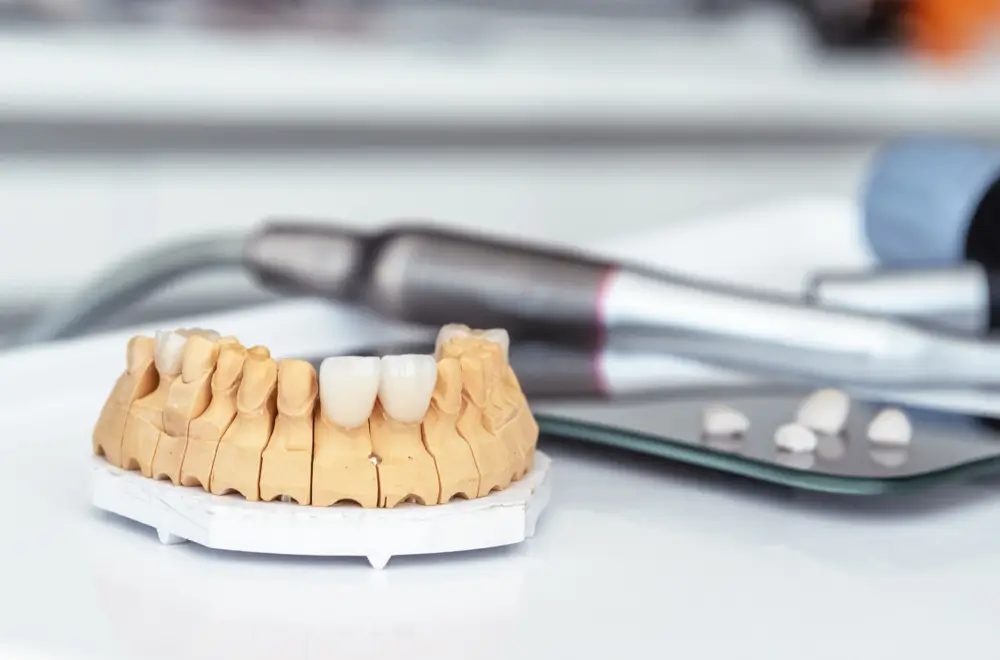In the field of cosmetic dentistry, the goal of achieving that perfect smile that is beautiful and flawless is more attainable than it has ever been.
Individuals who are interested in improving the appearance of their teeth have found that options such as veneers and Lumineers have become increasingly popular choice options as a result of advancements in dental technology.
Both of these choices come with their own set of advantages and have the potential to significantly enhance your smile.
However, it is essential to realize the distinctions between them in order to make an educated choice.
This article will explain more about what veneers and Lumineers are, as well as the similarities between the two, and walk you through the process of selecting the best option for your smile makeover.
Veneers: What Are They?
Dental veneers are thin shells that are made to order and are designed to cover the front surface of teeth in order to improve their appearance.
By bonding these shells to the teeth, the teeth undergo a transformation in terms of color, shape, size, or length.
Porcelain or resin-composite materials are typically used in the production of veneers, which are then made to be permanently bonded to the teeth.
They have the ability to treat a wide range of dental problems, including teeth that are discolored, worn down, chipped, or misaligned respectively.
Veneers made of porcelain are particularly well-liked because of their strength, durability, and natural appearance. They closely resemble the light-reflecting properties of natural teeth, which contribute to their popularity.
Lumineers: What Are Lumineers?
There is a specific kind of veneer known as Lumineers. These veneers are extremely thin and highly translucent, which enables them to imitate the natural appearance of enamel.
Lumineers are dental veneers that are made from a patented cerinate porcelain material. They are as thin as a contact lens and require very little to no tooth reduction prior to application.
The Lumineers procedure, in contrast to the traditional veneers, can be reversed due to this particular aspect. Two visits are required to apply Lumineers to the teeth, and if they are maintained properly, they can last for more than twenty years.
Those individuals who are looking for a solution that will improve the appearance of their smile without the permanence or invasiveness of traditional veneers will find that these veneers are the ideal solution.

The Comparative Analysis of Veneers and Lumineers
Lumineers and veneers have a number of similarities, despite the fact that they are distinct from one another.
A cosmetic solution that can correct imperfections such as staining, chips, and gaps between the teeth is provided by both of the available options.
They are individualized to fit the teeth of the person wearing them and have the potential to significantly enhance the appearance of a person’s smile.
Additionally, veneers and Lumineers are both well-known for their durability and long-lasting results, suggesting that they have the potential to improve the appearance of your smile for a considerable amount of time.
Recognizing the differences between these two options will assist you in determining which one is the most suitable for your dental requirements and aesthetic objectives. It is essential that you have a solid understanding of these similarities.
Veneers vs. Lumineers: Key Differences
While veneers and lumineers do share some similarities, their differences are significant and could impact your treatment decision. Three major distinctions stand out: invasiveness of the procedure, thickness of the material, and reversibility.
Traditional veneers are thicker and require the removal or reshaping of the existing tooth structure to accommodate the veneer. On the other hand, Lumineers are incredibly thin and require little to no alteration of the tooth, making the procedure less invasive.
The thickness of the material also affects the final aesthetic result. Since veneers are thicker, they may provide a higher level of opacity, ideal for teeth that are severely discolored. Lumineers, being thinner, may not offer the same level of color correction for extremely discolored teeth.
Lastly, the traditional veneers procedure is irreversible due to the alteration of your original teeth. In contrast, because no or minimal alteration is needed for Lumineers, the procedure is often reversible.
How Much Do Veneers and Lumineers Cost?
The dental lumineers cost and dental veneers cost depends on multiple factors such as the geographic location, the expertise of the dentist, the complexity of your case, and the number of teeth being treated.
On average, veneers may cost between $900 to $2,500 per tooth and can last 10 to 15 years. Lumineers can range from $800 to $2,000 per tooth and can last over 20 years. It is important to note that these are cosmetic procedures that are generally not covered by dental insurance.

Veneers and Lumineers: Pros & Cons
Understanding the advantages and disadvantages of veneers and Lumineers can help shape your decision. They both have unique benefits and limitations that may affect their suitability depending on your dental needs and cosmetic goals.
Pros and Cons of Veneers
Pros:
- They provide a natural tooth appearance.
- Porcelain veneers are stain-resistant.
- They offer a stronger and more opaque layer, which is ideal for covering darker teeth.
- The color can be customized to the rest of your teeth.
Cons:
- The process is irreversible.
- Teeth may become sensitive to hot and cold due to enamel removal.
- Although rare, veneers can dislodge or break and would then need to be replaced.
- They’re not a good option if you have decayed teeth, weak enamel, or gum disease.
Pros and Cons of Lumineers
Pros:
- No need for shots or tooth grinding in many cases, so they’re less painful.
- The process is reversible if no tooth reduction is required.
- They are thinner and can be a better option for minor cosmetic changes or when trying to correct the color of a tooth.
Cons:
- They might not be the best for darker teeth as they may not completely hide the discoloration because of their thinness.
- Some people feel Lumineers don’t look as natural as traditional veneers because they don’t follow the tooth’s natural contours.
- With their added thinness, they might be less resistant to cracking than traditional veneers.
Whether you opt for veneers or Lumineers, your dentist can guide you in making the best decision based on your dental health and cosmetic goals.
Veneers & Lumineers FAQs
Are Lumineers the Same as Composite Veneers?
No, Lumineers are not the same as composite veneers. Lumineers are a type of porcelain veneer that are ultra-thin and translucent, designed to mimic the natural appearance of tooth enamel. Composite veneers, on the other hand, are made from a tooth-colored resin, similar to what’s used in dental fillings.
Is It Possible To Remove Lumineers And Return To The Original Teeth?
Yes, it is typically possible to remove Lumineers and return to the original teeth, especially if no tooth reduction was required upon their application. This is because Lumineers are so thin and can often be placed with little to no modification to the existing teeth, which makes the procedure potentially reversible.
How to Look After Veneers and Lumineers?
Care for veneers and Lumineers is similar to caring for your natural teeth. Regular brushing and flossing, along with regular dental checkups, are a must. Avoid biting hard objects, such as ice or your fingernails, as this can damage them. If you grind or clench your teeth at night, a nightguard may be recommended to protect your veneers or Lumineers.
Which are More Expensive Veneers or Lumineers?
The cost can vary greatly depending on various factors, including geographic location and the individual dentist’s expertise. On average, both veneers and Lumineers may cost between $800 and $2,500 per tooth, making them roughly comparable in price. It’s important to discuss pricing with your dentist, and remember that these procedures are typically considered cosmetic and may not be covered by insurance.

Should You Get Lumineers or Veneers?
The decision to choose between Lumineers and veneers depends on your unique dental needs and cosmetic goals. Lumineers could be an ideal solution for those seeking a less invasive, potentially reversible option for cosmetic enhancement, while veneers might be a preferred choice for those desiring comprehensive color correction and a more significant change in tooth shape or size.
Celebrity cosmetic dentist Dr. Saif Shere, specializing in dental veneers and cosmetic dentistry, is an expert guide in helping determine which option is best for you. With a unique blend of technical skill, artistry, and dedication to patient comfort, Dr. Shere provides exceptional cosmetic dental solutions tailored uniquely to each patient’s needs and desires.
As you explore your options, remember that ultimately, the most important thing is to enhance your smile in a way that boosts your confidence and improves your overall oral health. Whether you choose veneers or Lumineers, you’re on your way to a more radiant smile.